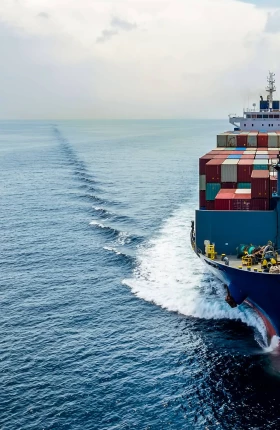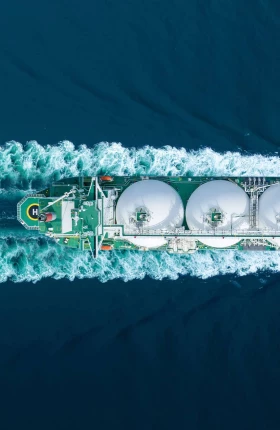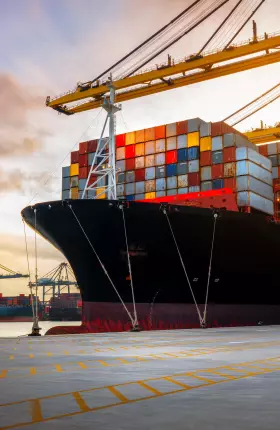In September 2023, the Global Centre for Maritime Decarbonisation (GCMD) and Boston Consulting Group (BCG) released an inaugural report on the state of maritime decarbonization, featuring data collected from ship owners and operators. To track the industry’s progress since then, GCMD and BCG are publishing a second report on the topic. The data in this new report was gathered from a fresh survey conducted October 2024 through February 2025. Since then, the world of shipping has faced more uncertainties following a wave of new trade tariff declarations. At the same time, it has also witnessed the approval of the world’s first greenhouse gas (GHG) pricing framework, marking a pivotal step toward curbing maritime
An Evolving Regulatory Landscape
Over the past decade, policies and regulations aimed at fostering maritime decarbonization have progressed significantly, evolving from energy efficiency requirements—such as the Ship Energy Efficiency Management Plan and Energy Efficient Design Index—to more ambitious measures like the Energy Efficiency Existing Ship Index and the Carbon Intensity Indicator, both of which came into force in January 2023. These regulations have prompted vessel owners to deploy decarbonization solutions (such as advanced propeller designs and hull coatings) and to adopt more efficient operational practices (including slow steaming and frequent hull cleaning).
Momentum accelerated in July 2023 when the International Maritime Organization (IMO) revised its GHG strategy, which set more ambitious targets relative to 2008: a 20% to 30% GHG reduction by 2030, 70% to 80% by 2040, and net zero by about 2050. In parallel, the European Union has enacted new regulations that include an extension of the Emissions Trading System to the maritime industry and the introduction of the FuelEU Maritime Regulation.
Most recently, in April 2025, outcomes from the 83rd session of the IMO’s Marine Environment Protection Committee (MEPC 83) signaled stronger demand for low-carbon fuels, with additional GHG Fuel Intensity (GFI) targets being introduced along with incentives for exceeding compliance goals and penalty mechanisms for shortfalls.
Rising Global Headwinds
Despite an abundance of encouraging regulatory developments targeting maritime decarbonization, uncertainties began to emerge in late 2024 across the broader ecosystem necessary for its success. In the United States, for example, the pausing of renewable energy incentives passed in 2022 may slow investment in projects for producing low-carbon fuels. At the same time, the uncertain and disruptive global tariff environment threatens to trigger stagflation, potentially forcing governments to redirect fiscal resources toward economic support. Geopolitical instability posed by the war in Ukraine and the rhetoric suggesting the possibility of the United States scaling back its security commitments to Europe could also prompt increased government spending on defense. Meanwhile, cost-of-living concerns have dominated election debates globally, contributing to business uncertainties and dampening market sentiments. These converging macroeconomic and geopolitical pressures risk diverting attention and resources away from climate action.
Taken as a whole, while regulatory regimes continue to move toward stricter emissions standards, the journey will be increasingly dependent on how effectively ship owners and operators navigate these complex global headwinds.
Stay ahead with BCG insights on transportation and logistics
Survey Scope and Participation
This survey explored how industry ambitions and challenges have developed over the past few years by analyzing 114 responses from a diverse group of ship owners and operators. Participants have various vessel types (including tankers and mixed fleets), fleet sizes, and annual revenues (ranging from less than $10 million to more than $10 billion). Participants also have operations in several regions (Europe, the United States, the Middle East, and Asia-Pacific). Forty-two companies contributed to the inaugural survey and then again to the new survey. In addition, insights from the global bunkering hubs of Port of Antwerp-Bruges, Port of Rotterdam, and Port of Singapore, as well as the main bunkering hubs in the United States—Port of Long Beach and the Port of New York and New Jersey—were collected through related port surveys and interviews.
Ambitions, Adoptions, and Challenges
Despite the uncertainty in the broader ecosystem, our new survey shows that decarbonization ambitions remain intact in the shipping industry. Among our respondents, 77% consider net zero a high or essential priority—up from 73% in our inaugural survey that was conducted November 2022 through March 2023—and 60% have net zero targets, up from 54%. In tandem with heightened ambitions, the adoption of decarbonization solutions has also risen. Nearly half (46%) of survey respondents are adopting bioblended fuels, up from 22%, and 6% are adopting methanol, up from 3%. Similarly, the adoption of technological and operational efficiency levers (TOLs) has increased. The higher adoption of decarbonization solutions over the past decades, influenced by policy interventions, has helped keep emissions relatively flat despite the increase in seaborne trade over the same period.
Nearly half of survey respondents are adopting bioblended fuels, up from 22%, and 6% are adopting methanol, up from 3%.
Nonetheless, the deployment of nascent solutions—including ammonia and methanol fuels, wind-assisted propulsion systems, solar panels, superlight ships, optimized water flow through hull openings, and air lubrication—remains limited as a percentage of ship owners’ fleets. For example, methanol adopters have deployed the fuel in less than one-fifth of their fleets. Similarly, more than half of nascent TOL adopters reported using those TOLs in less than 20% of their fleets.
Progress is also evident in solutions’ technology readiness, which is increasingly less of a barrier. While many solutions have already achieved the highest technology-readiness level (TRL) of nine since the inaugural
The economic hurdles are well understood and remain a significant issue across many decarbonization solutions. Economic viability has been cited as the top challenge for the adoption of bioblended fuels by 52% of respondents, for the adoption of methanol by 44%, and for the adoption of ammonia by 39%. BCG’s Synfuel Cost Model predicts 2030 production costs of $51 to $84 per gigajoule (GJ) for e-methanol and $46 to $72 per GJ for green ammonia, both of which are much higher even when compared with the trading price of low-sulfur fuel oil at $13 per GJ (as of February
Almost three-fourths of respondents identified either compliance measures or financial incentives and subsidies as the most important policy objectives.
To further enable decarbonization, policies and regulations are widely seen as essential to creating a level playing field. Nearly three-fourths (72%) of respondents identified either compliance measures (such as mandating and enforcing decarbonization along with setting clear targets and timelines) or financial incentives and subsidies as the most important policy objectives. Such views clearly reflect respondents’ wishes both for industry-wide compliance that prevents early adopters from being competitively disadvantaged from a cost standpoint and for support that addresses economic barriers to allow more stakeholders—particularly those limited by financial constraints—to participate. The recently approved two-tiered, GFI-linked pricing mechanism from the April 2025 MEPC 83 session is a step toward leveling the playing field and providing the industry with the additional certainty it has been seeking to take strategic and commercial action on shipping fleets.
Three Archetypes of Ship Owners and Operators
As defined in our inaugural report, ship owners and operators are categorized into three archetypes—Frontrunners, Followers, and Conservatives—depending on the extent of their adoption of decarbonization solutions. The archetypes have varying levels of ambitions, and each faces a distinct set of challenges.
Frontrunners lead in decarbonization ambitions, with a majority of them placing net zero as a high priority and having dedicated sustainability teams, putting them ahead of the curve considering the recently introduced GHG pricing framework. They grapple primarily with implementation-based hurdles. These shipping companies cite high capex requirements to scale nascent TOLs as their top challenge. Economic viability, limited fuel supply, and availability of bunkering infrastructure represent further hurdles for the adoption of low-carbon fuels.
Followers show notable commitment to decarbonization, although they trail Frontrunners in viewing net zero as a priority and in setting up dedicated sustainability teams. They deal mainly with assessment-based barriers. Their top challenge relates to knowledge constraints about the performance and returns of nascent TOLs. Similarly to Frontrunners, they cite economic viability, the limited supply of low-carbon fuels, and the limited availability of bunkering infrastructure as major bottlenecks.
Conservatives are in the early stages of their decarbonization journey, with only a third having dedicated sustainability teams. They predominantly face initiation-based concerns. They struggle mainly with limited awareness of TOLs and the economic viability for adopting low-carbon fuels.
Among our 42 repeat respondents, 14 have moved forward in their adoption of decarbonization solutions, suggesting real progress. Those that shifted among archetypes reflect a diverse range regarding their vessel types, fleet sizes, and regions, implying a broad-based evolution not confined to any one group. Notably, their challenges and issues aligned with the trends observed in the full sample.
Among our 42 repeat respondents, 14 have moved forward in their adoption of decarbonization solutions, suggesting real progress.
While these archetypes appear across the industry, there are some noteworthy trends. More than half of the surveyed companies that operate liners—vessels that operate on fixed routes—are Frontrunners. This is likely owing to several factors, including the predictability of their fixed routes and their ability to pass on costs to end customers. Such factors simplify the adoption of decarbonization solutions and provide a stronger impetus for their implementation. More than half of the container shipping companies surveyed are also Frontrunners, which is expected since 85% of the container shipping companies surveyed identified themselves as liners.
Fleet size also influences archetype, as 63% of companies with more than 100 vessels are Frontrunners—likely because they have the resources and ability to adopt decarbonization solutions and face greater industry scrutiny on emissions.
While these generalizations hold, heterogeneity still exists across the industry. For example, Conservatives and Followers are among the ship owners with larger fleet sizes, and Frontrunners are among those with smaller fleet sizes. Similarly, Conservatives and Followers are among ship owners with container ships, while Frontrunners are among those with other vessel types.
Support from ports is critical in enabling ships to decarbonize, particularly for the adoption of low-carbon fuels. The majority of the five bunkering ports across the United States, Europe, and Asia-Pacific that we surveyed and interviewed have roadmaps and teams focused on initiatives to help ships decarbonize. All surveyed ports offer green incentives. Still, they are concerned with the lack of demand certainty from shipping companies for both low-carbon fuels and OCCS. This situation creates a chicken-and-egg dilemma in which ships struggle to invest in low-carbon-fuel engines or OCCS systems in the absence of shore-side infrastructure, and ports hesitate to develop the necessary infrastructure without demand certainty from shipping companies. However, the recently introduced GHG pricing mechanism is expected to strengthen demand signals for low-carbon fuels.
Actions Required
Since our inaugural survey, shipping has made notable strides in elevating and sustaining maritime decarbonization ambitions. Nonetheless, as with any multifaceted pursuit, the most significant barrier is effective implementation, a hurdle currently heightened by broader ecosystem challenges beyond shipping.
Drawing on insights from our industry survey and interviews, three enablers—globally consistent regulations, bunkering ports’ support, and data sharing—have been identified as critical to help establish four key initiatives for realizing the sector’s decarbonization ambitions:
- Level the playing field with policies and regulations. These are needed to ensure that first movers are not competitively disadvantaged and to potentially offer financial assistance to Conservatives. The recently approved GHG pricing structure is a step in the right direction.
- Foster economic viability through incentives and financing mechanisms, since the adoption of decarbonization solutions often comes with higher costs.
- Signal demand certainty for infrastructure investment in order to ensure that shore-side providers have the certainty and visibility needed to justify their business cases.
- Bridge awareness and knowledge gaps, particularly among Conservatives and Followers, to foster broader adoption of TOLs.
Ultimately, with the right investments and actions, the maritime industry can chart a course to a future where sustainable decarbonization and commercial success can thrive in harmony.






